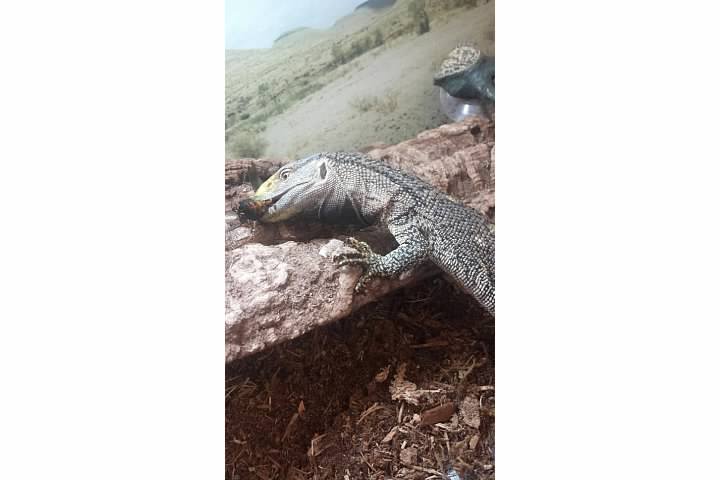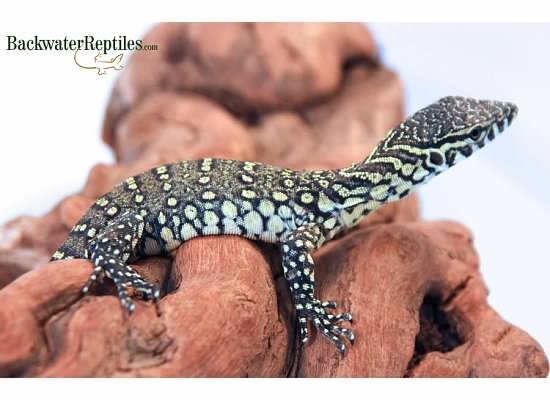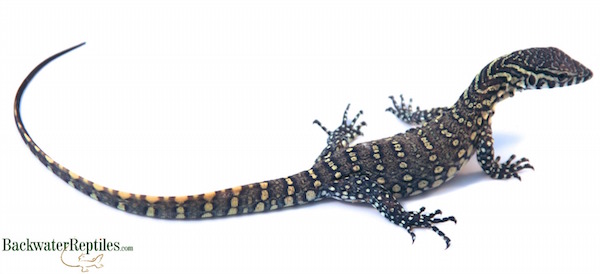Which monitor lizards make the best pets? We ship out a lot of monitor lizards here at Backwater Reptiles – they’re popular reptile pets! Because monitor lizards can grow to a large size quite quickly, we wanted to make sure potential new owners get as much info as possible and know exactly what they are in for long term. That’s why this blog entry is all about our most popular monitor lizards.
Black Throat Monitors (Varanus albigularis ionidesi)
Overall, Black Throat Monitors are docile lizards. With proper handling and care, they will overcome most aggressive behaviors and make excellent pet lizards. In fact, many people enjoy taking their Black Throat out for a stroll on a leash (always do so responsibly and securely). It’s healthy for the lizard to get exercise and natural sunshine, plus we guarantee people will stop and ask you questions! Remember, you’re a representative of the reptile community, so propagating a positive view of our hobby is hugely important.
Like most pet monitors, when full-grown, these guys will require a very large, spacious enclosure. In addition to invertebrates, they will eat whole rodents and other small mammals, including thawed mice and chicks (rodents are always better–their bones contain more calcium than bird bones), so make sure you don’t have a queasy stomach if you want a monitor of any kind.
Black Throats are not avid climbers nor particularly good at swimming, so it’s not necessary to give them climbing or swimming equipment like some monitors would require. However, a clean water dish is still a must.
All monitor species are very intelligent as far as lizards are concerned. However, Black Throats have been known to be able to internally count to seven! They can also recognize their keepers/owners, and can solve fairly involved food tests.
At our facility, we have a nearly five-foot long Blackthroat that is not only tame, but will walk to us when we slap the ground with our hand. We raised him from a baby that fit on our index finger, to a four-footer, inside one year. This should give you an idea of how quickly they can grow if provided with quality foods and heat.
Currently, Backwater Reptiles has hatchling and 14 to 18 inch long Black Throat Monitors ready to go. We get them in regularly, and cannot recommend them more highly if you are prepared for a large reptile pet.
White Throat Monitors (Varanus albigularis)
Also known as Cape Monitors, White Throats have larger, more bulbous noses than most other monitor species, particularly when they are mature. They have raised, almost cone-shaped neck scales and can be accented with yellowish-colored stripes, bands, or splotches. As suggested by their common name, their throats tend to be lighter in color than the rest of their body.
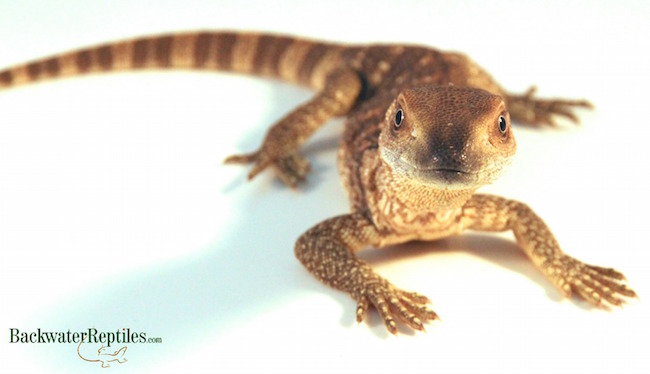
White Throats grow anywhere from three to six feet long and will live around 12 to 20 years. Males are longer and heavier than females.
Although they are mostly diurnal, grund-dwelling lizards, it is not unheard of for White Throats to climb trees. This means that in addition to supplying a very large, spacious enclosure to keep your adult monitor, you should also provide some type of branch or safely secured climbing apparatus.
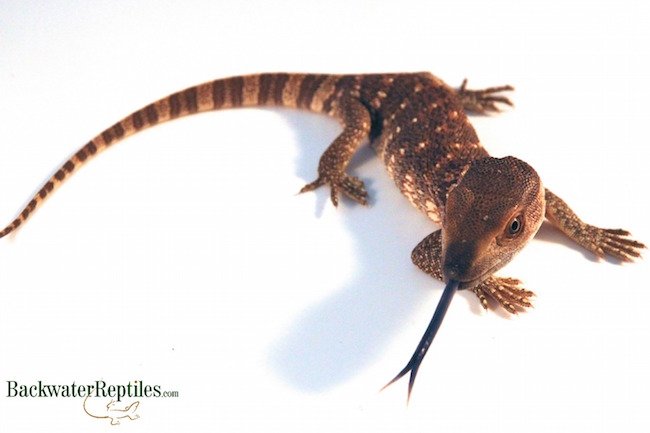
White Throats love to drink water, so be sure there is always a fresh supply in their enclosure. Keep the dish clean and remove any feces or food that might collect inside of it. Also be aware of how often your White Throat soaks in his/her water dish as this could be an indicator that there is not enough humidity present in his/her environment (this is true for most lizard species).
Backwater Reptiles currently has hatchling White Throat Monitors available. This species is not available nearly as often as the Black throat monitors. These little guys won’t need a gigantic enclosure for a while yet, although they do grow quickly!
Savannah Monitors (Varanus exanthematicus)
The highly intelligent Savannah Monitor requires stimulation and activity outside of its enclosure. Like all adult monitors, they will require a large habitat to live in, but they should also be given time outside their enclosure to exercise. They will thrive if their lifestyle is “exciting” – at least for a lizard.
Savannahs are probably the most manageable of the monitor lizards as far as size and enclosure size is concerned. Savannahs will grow to be an average of two and a half to three and a half feet in length and will live around twenty years if properly cared for.

If there is enough space, food, hiding space, and all other requirements are met, Savannah Monitors can even be kept communally, although it is not advisable to keep multiple males together.
Because Savannahs are avid burrowers, it is absolutely essential that their enclosure have a substrate that fosters this natural behavior. Cage decor should be minimal because burrowing will topple things and you don’t want anything to fall and harm the lizard.
The Savannah Monitor’s diet is very similar to that of all other monitor lizard species. Whole rodents and large insects should be the staples of a Savannah’s diet and fresh water should always be available.
Backwater Reptiles has hatchling and juvenile Savannah Monitors in stock and ready to ship. We’ve even got an anerythristic morph!
Nile Monitors (Varanus niloticus)
Of all the monitor lizards, Nile Monitors are probably the toughest to keep. They often times have aggressive temperaments (for the most part) and unless you’re an experienced herper, it’s best if they’re not handled. They tend to hiss, bite, and whip their tails at their keepers, even when handled consistently from a young age. They’re are always exceptions to every rule, but they generally make better display pets.
As their name suggests, Nile Monitors are excellent swimmers and even have flattened out rudder-like tails to assist them while in the water. This means that in order to keep a healthy, happy Nile Monitor, it should have an enclosure large enough to hold the six foot long adult lizard complete with an area for soaking and swimming. Make sure to keep the water container clean as these monitors will often defecate in the water.
Like all other monitors, the Nile Monitor’s diet should be as varied as possible, but include lots of large insects and whole rodents. These guys sure do have appetites!
Backwater Reptiles has very affordable hatchling Nile Monitors nearly year round.
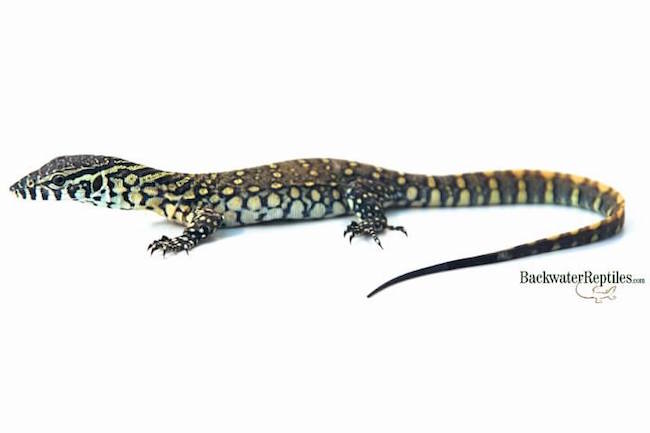
We hope we’ve taught you a thing or two about the most popular pet monitor lizards. What do you think the best pet monitor lizard is?


